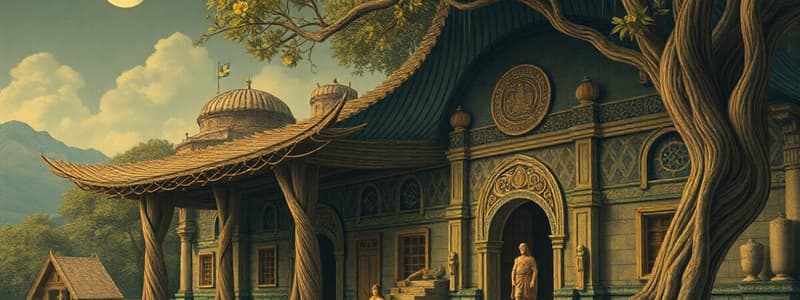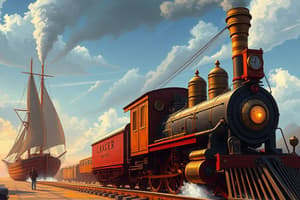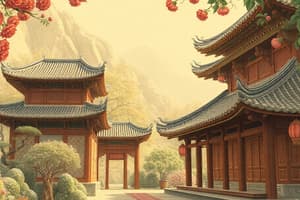Podcast
Questions and Answers
What was the primary purpose of cuneiform in its early use?
What was the primary purpose of cuneiform in its early use?
- To document trade transactions (correct)
- To create literature
- To train scribes
- To record historical events
Which of the following materials was developed during the Bronze Age?
Which of the following materials was developed during the Bronze Age?
- Copper
- Clay
- Tin
- Bronze (correct)
What role did scribes play in early Sumerian civilization?
What role did scribes play in early Sumerian civilization?
- They were warriors
- They wrote down important information (correct)
- They managed agriculture
- They created pottery
What did improved technology in Sumer primarily enhance?
What did improved technology in Sumer primarily enhance?
The Epic of Gilgamesh can be characterized as:
The Epic of Gilgamesh can be characterized as:
Which agricultural advancement involved using animals in Sumer?
Which agricultural advancement involved using animals in Sumer?
What was NOT a function of record keeping in early Sumerian civilization?
What was NOT a function of record keeping in early Sumerian civilization?
What significant term is associated with the period when bronze was developed?
What significant term is associated with the period when bronze was developed?
What was one of the results of specialization in ancient societies?
What was one of the results of specialization in ancient societies?
What material was initially used for tools and weapons before bronze?
What material was initially used for tools and weapons before bronze?
Who were the skilled workers that produced goods by hand in specialized areas?
Who were the skilled workers that produced goods by hand in specialized areas?
What defines a city-state in the context of ancient civilization?
What defines a city-state in the context of ancient civilization?
What is an example of a complex institution in ancient civilizations?
What is an example of a complex institution in ancient civilizations?
Which role did priests and religious leaders play in ancient city-states?
Which role did priests and religious leaders play in ancient city-states?
How did the influence of religious leaders manifest in ancient governments?
How did the influence of religious leaders manifest in ancient governments?
What role did merchants serve in developing ancient civilizations?
What role did merchants serve in developing ancient civilizations?
What characteristic of civilization refers to the development of distinct job roles beyond food production?
What characteristic of civilization refers to the development of distinct job roles beyond food production?
Which advancement helped traders travel longer distances in Sumerian civilization?
Which advancement helped traders travel longer distances in Sumerian civilization?
What was one social change that occurred as a result of agriculture in ancient civilizations?
What was one social change that occurred as a result of agriculture in ancient civilizations?
How many characteristics are typically defined for a civilization?
How many characteristics are typically defined for a civilization?
Which of the following cities is recognized as having the largest population in Sumer?
Which of the following cities is recognized as having the largest population in Sumer?
In Sumerian civilization, what aspect of religion was notably reorganized?
In Sumerian civilization, what aspect of religion was notably reorganized?
How did irrigation impact social structure within Sumerian communities?
How did irrigation impact social structure within Sumerian communities?
Which characteristic of civilization relates to the ability to maintain complex organizations and governance?
Which characteristic of civilization relates to the ability to maintain complex organizations and governance?
Flashcards
Specialization
Specialization
The ability to perform a certain job or task very well due to specialized training or experience.
Artisans
Artisans
A group of skilled workers who create goods by hand.
Institution
Institution
A long-lasting pattern of organization within a community with a specific purpose.
City-state
City-state
Signup and view all the flashcards
Priest
Priest
Signup and view all the flashcards
Polytheism
Polytheism
Signup and view all the flashcards
Ziggurat
Ziggurat
Signup and view all the flashcards
Theocracy
Theocracy
Signup and view all the flashcards
The Impact of Agriculture
The Impact of Agriculture
Signup and view all the flashcards
Irrigation Systems
Irrigation Systems
Signup and view all the flashcards
Specialized Workers
Specialized Workers
Signup and view all the flashcards
Transportation Innovations
Transportation Innovations
Signup and view all the flashcards
Social Class Development
Social Class Development
Signup and view all the flashcards
The Rise of Slavery
The Rise of Slavery
Signup and view all the flashcards
Religious Practices
Religious Practices
Signup and view all the flashcards
Defining Civilization
Defining Civilization
Signup and view all the flashcards
What was cuneiform?
What was cuneiform?
Signup and view all the flashcards
What is the Epic of Gilgamesh?
What is the Epic of Gilgamesh?
Signup and view all the flashcards
Who were scribes?
Who were scribes?
Signup and view all the flashcards
Why was record-keeping important in ancient Sumer?
Why was record-keeping important in ancient Sumer?
Signup and view all the flashcards
What technological advancements did the Sumerians achieve?
What technological advancements did the Sumerians achieve?
Signup and view all the flashcards
What is bronze and why was it significant?
What is bronze and why was it significant?
Signup and view all the flashcards
What is technology?
What is technology?
Signup and view all the flashcards
How did improved technology affect life in ancient Sumer?
How did improved technology affect life in ancient Sumer?
Signup and view all the flashcards
Study Notes
Innovation and Change
- Innovations during the Paleolithic Period (before c. 10,000 BCE) are significant.
- Innovations during the Neolithic Period (c. 10,000 BCE to between 4500 and 2000 BCE) are significant.
- The Neolithic Revolution led to the rise of civilization.
- Key innovations from the Ancient, Pre-Modern, and Modern Eras are significant.
Invention vs. Innovation
- An invention is a completely new object or method.
- An innovation is a change to an existing object or method that improves effectiveness or efficiency.
Determining Historical Significance
- Magnitude: Importance of the event or change.
- Scope: How widely the effects spread.
- Duration: How long the effects are experienced.
Human Origins in Africa
- Early Hominid Discovery: Mary Leakey's team discovered prehistoric footprints in 1978, and Donald Johanson discovered "Lucy" in 1974, both with important implications for understanding human origins and evolution.
- Paleolithic Era (2.5 million years ago to 8,000 BCE): characterized by the development of tools, mastery of fire, development of language.
- Hominid Developments: Include Australopithecines, Homo habilis (first to make stone tools), Homo erectus (migrated and may have used language), Archaic Humans (Homo heidelbergensis and Neanderthals), and Early Modern Humans/Cro-Magnon.
- Key developments include bipedalism (walking upright) and tool-making, which allowed for greater mobility, dietary diversity, and social interaction.
The Neolithic Revolution
- Beginning of agriculture (c. 8000 BCE): Humans discovered the role of cultivating crops instead of foraging.
- Causes of the Agricultural Revolution: Climate change, including warmer temperatures.
- Early Farming Methods: Slash-and-burn and domesticating animals to increase food supply.
- Agriculture Spreads: Around 9,000 years ago, agriculture spread from the Zagros Mountains of Northeast Iraq (Jarmo), to Africa (Nile River), China (Huang He River), Mexico, and Central America.
- Catal Huyuk as an example of an early Neolithic village, demonstrating a settled agricultural lifestyle.
Civilization
- Agriculture caused a shift from nomadic life to settled agricultural communities and eventually to cities.
- Characteristics of Civilization: Advanced cities, specialized workers, complex institutions, record keeping, and improved technology.
- Sumerian Civilization developed one of the world's first writing systems (cuneiform) and complex institutions.
Ancient Innovations
- Phoenician Boats: Used for trade in the eastern Mediterranean. The creation and use of ships with superior design for trade made trade operations more efficient.
- Roman Aqueducts: System of channels for transporting water. Enabled the growth of large cities and helped with sanitation, irrigation and various needs for the towns.
Medieval Innovations
- Stirrup: Innovation created around 1000 BCE, revolutionized warfare by providing stability for riders and facilitating combat tactics.
- Printing Press: Developed by Gutenberg in 1452, enabled mass production of books, leading to the spread of knowledge, and increased literacy.
Early Modern Innovations
- Smallpox Vaccine: Developed by Edward Jenner, preventing deaths, disfigurement, and providing immunity to one of the most devastating disease of that era.
- Steam Engine: Invented in the 1700s in Britain, dramatically increased production, powering factories, boats, and locomotives, greatly reducing travel times by land and sea, and leading to changes in the work conditions.
Studying That Suits You
Use AI to generate personalized quizzes and flashcards to suit your learning preferences.




